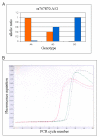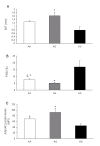Genetic variation in the adiponectin receptor 2 (ADIPOR2) gene is associated with coronary artery disease and increased ADIPOR2 expression in peripheral monocytes
- PMID: 20178558
- PMCID: PMC2846898
- DOI: 10.1186/1475-2840-9-10
Genetic variation in the adiponectin receptor 2 (ADIPOR2) gene is associated with coronary artery disease and increased ADIPOR2 expression in peripheral monocytes
Abstract
Background: Adiponectin is an adipose tissue secreted protein known for its insulin sensitising and anti-atherogenic actions. To this date two adiponectin receptors have been discovered, adiponectin receptor 1 (ADIPOR1) and adiponectin receptor 2 (ADIPOR2). The aim of this study was to investigate the association of ADIPOR2 gene variations with coronary artery disease (CAD).
Methods: Eight common single nucleotide polymorphisms (SNPs) spanning the entire ADIPOR2 locus were chosen to perform association studies with anthropometric and metabolic parameters in a Greek population. They were classified as either CAD (stenosis >50% in at least one main vessel) or non-CAD individuals in accordance with coronary angiography data.Genotyping was performed using a microsphere-based suspension array and the Allele Specific Primer Extension (ASPE) method. Expression of ADIPOR2 protein and mRNA in circulating CD14+ monocytes were determined using flow cytometry and real time Polymerase Chain Reaction assays respectively.
Results: There was a significant difference in the distribution of genotypes of polymorphism rs767870 of ADIPOR2 between CAD and non-CAD individuals (p = 0.017). Furthermore, heterozygotes of the rs767870 polymorphism had significantly lower Flow Mediated Dilatation (FMD) values, higher values of Intima-Media Thickness (IMT) and increased ADIPOR2 protein levels in peripheral monocytes, compared to homozygotes of the minor allele after adjustment for age, sex, waist to hip ratio and HOMA.
Conclusions: Our findings suggest that variants of ADIPOR2 could be a determinant for atherosclerosis independent of insulin resistance status, possibly by affecting ADIPOR2 protein levels.
Figures




Similar articles
-
Arterial stiffness is associated with increased monocyte expression of adiponectin receptor mRNA and protein in patients with coronary artery disease.Am J Hypertens. 2012 Jul;25(7):746-55. doi: 10.1038/ajh.2012.42. Epub 2012 Apr 26. Am J Hypertens. 2012. PMID: 22534793
-
Adiponectin levels and expression of adiponectin receptors in isolated monocytes from overweight patients with coronary artery disease.Cardiovasc Diabetol. 2011 Feb 1;10:14. doi: 10.1186/1475-2840-10-14. Cardiovasc Diabetol. 2011. PMID: 21284833 Free PMC article.
-
Are decreased AdipoR1 mRNA levels associated with adiponectin resistance in coronary artery disease patients?Clin Exp Pharmacol Physiol. 2015 Apr;42(4):331-6. doi: 10.1111/1440-1681.12361. Clin Exp Pharmacol Physiol. 2015. PMID: 25582653
-
Genetic influences of adiponectin on insulin resistance, type 2 diabetes, and cardiovascular disease.Diabetes. 2007 May;56(5):1198-209. doi: 10.2337/db06-0506. Epub 2007 Feb 15. Diabetes. 2007. PMID: 17303804 Review.
-
Single-nucleotide polymorphisms in adiponectin, AdipoR1, and AdipoR2 genes: insulin resistance and type 2 diabetes mellitus candidate genes.Am J Ther. 2013 Jul-Aug;20(4):414-21. doi: 10.1097/MJT.0b013e318235f206. Am J Ther. 2013. PMID: 23656997 Review.
Cited by
-
KCNQ1 gene polymorphisms are associated with lipid parameters in a Chinese Han population.Cardiovasc Diabetol. 2010 Aug 11;9:35. doi: 10.1186/1475-2840-9-35. Cardiovasc Diabetol. 2010. PMID: 20701788 Free PMC article.
-
The genetics of obesity and the metabolic syndrome.Endocr Metab Immune Disord Drug Targets. 2010 Jun;10(2):86-108. doi: 10.2174/187153010791213100. Endocr Metab Immune Disord Drug Targets. 2010. PMID: 20406164 Free PMC article. Review.
-
A comprehensive investigation of variants in genes encoding adiponectin (ADIPOQ) and its receptors (ADIPOR1/R2), and their association with serum adiponectin, type 2 diabetes, insulin resistance and the metabolic syndrome.BMC Med Genet. 2013 Jan 25;14:15. doi: 10.1186/1471-2350-14-15. BMC Med Genet. 2013. PMID: 23351195 Free PMC article.
-
Adiponectin receptor 1 gene is potentially associated with severity of postoperative pain but not cancer pain.Medicine (Baltimore). 2020 Jan;99(5):e18924. doi: 10.1097/MD.0000000000018924. Medicine (Baltimore). 2020. PMID: 32000405 Free PMC article.
-
A genome-wide association study reveals a quantitative trait locus of adiponectin on CDH13 that predicts cardiometabolic outcomes.Diabetes. 2011 Sep;60(9):2417-23. doi: 10.2337/db10-1321. Epub 2011 Jul 19. Diabetes. 2011. PMID: 21771975 Free PMC article.
References
-
- Hu E, Liang P, Spiegelman PM. AdipoQ is a novel adipose-specific gene dysregulated in obesity. J Biol Chem. 1995;27:110697–10703. - PubMed
-
- Nakano Y, Tobe T, Choi-Miura NH, Mazda T, Tomita M. Isolation and characterisation of GBP28, a novel gelatin binding protein purified from human plasma. J Biochem. 1996;120:803–812. - PubMed
Publication types
MeSH terms
Substances
LinkOut - more resources
Full Text Sources
Other Literature Sources
Research Materials
Miscellaneous

